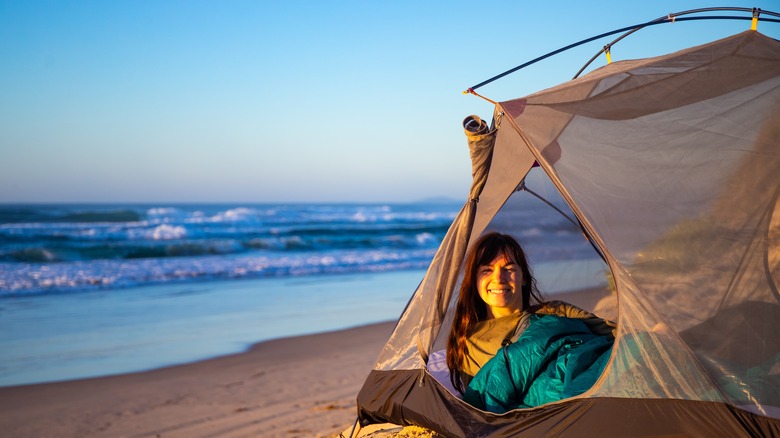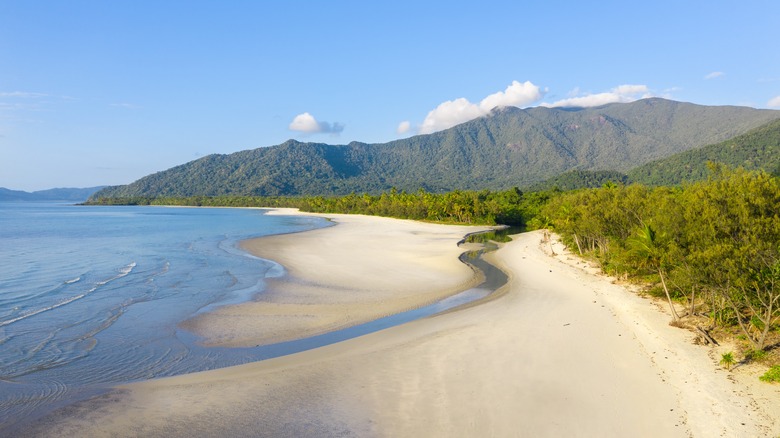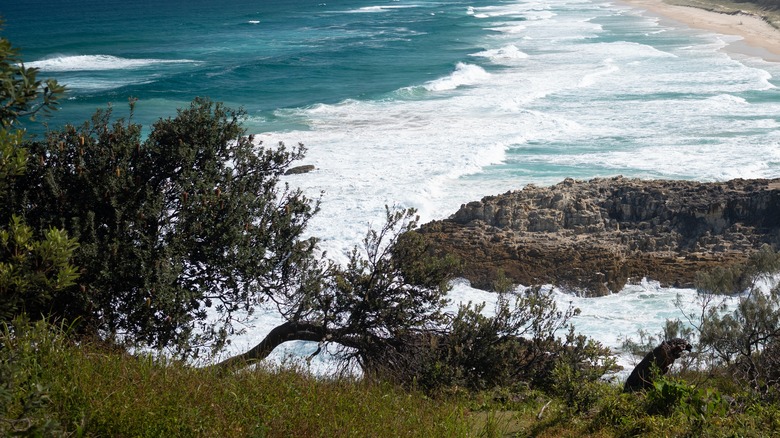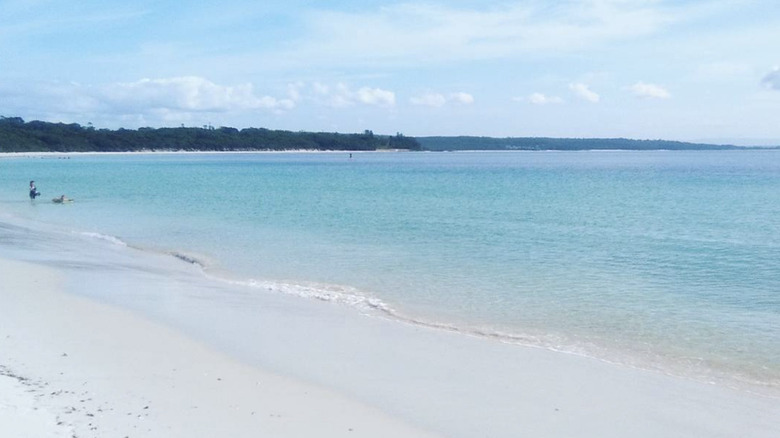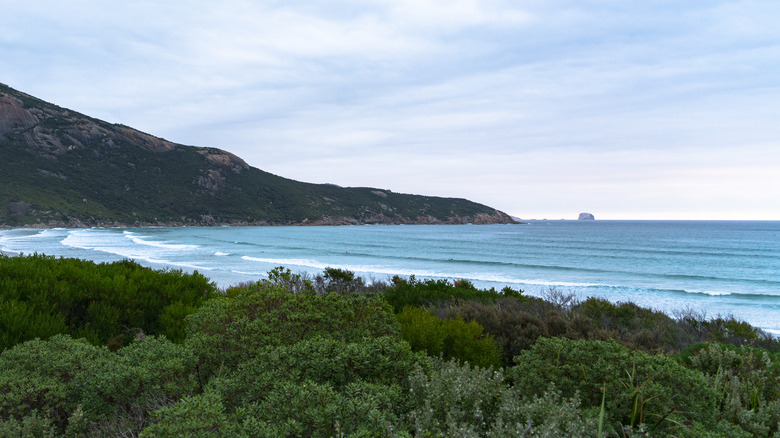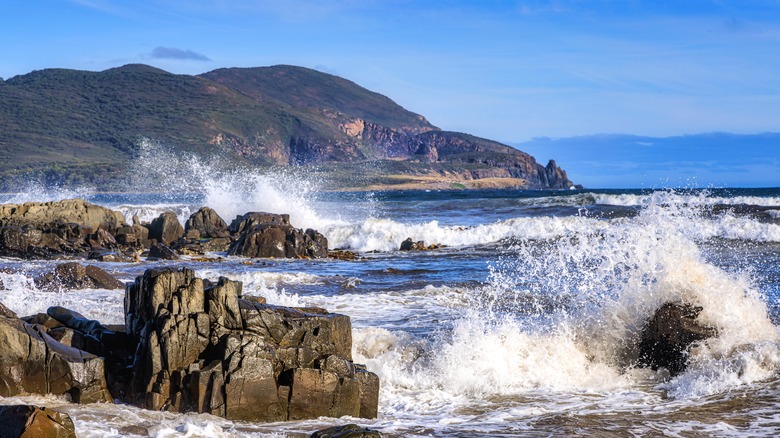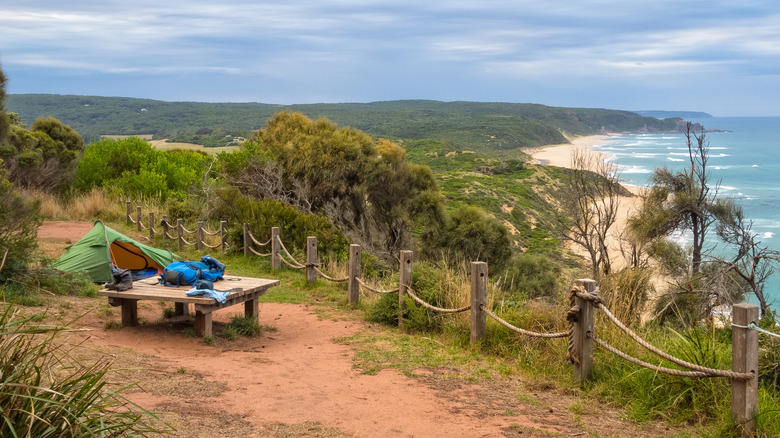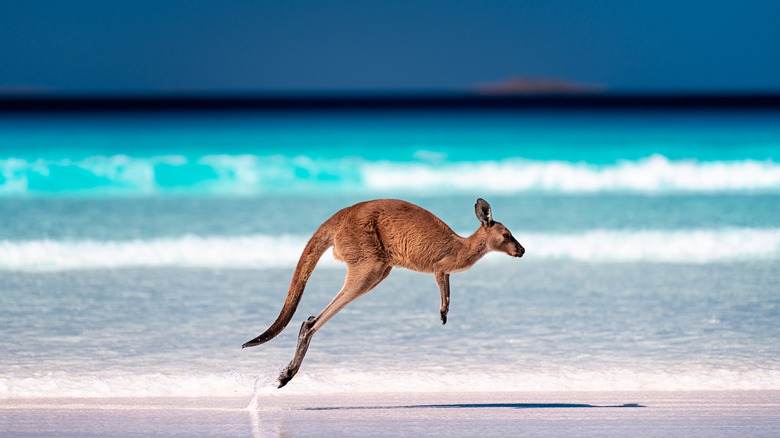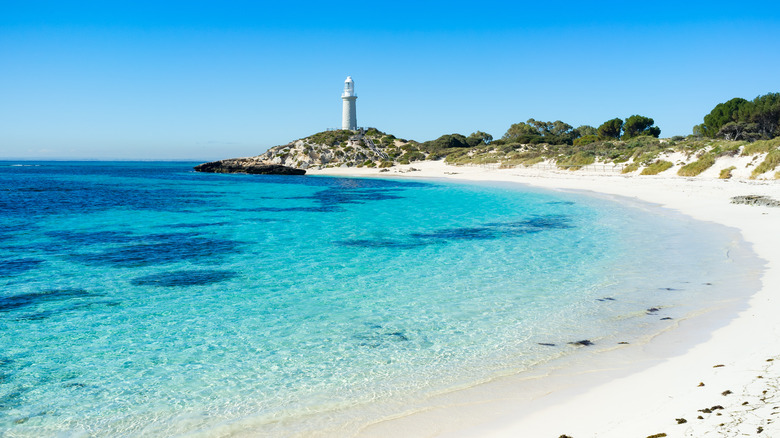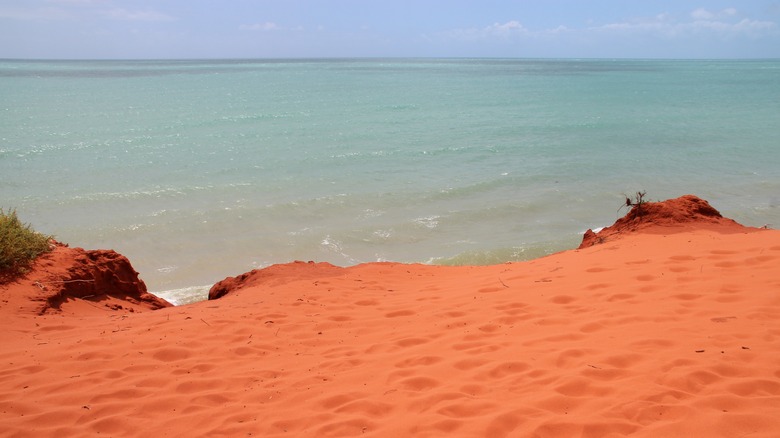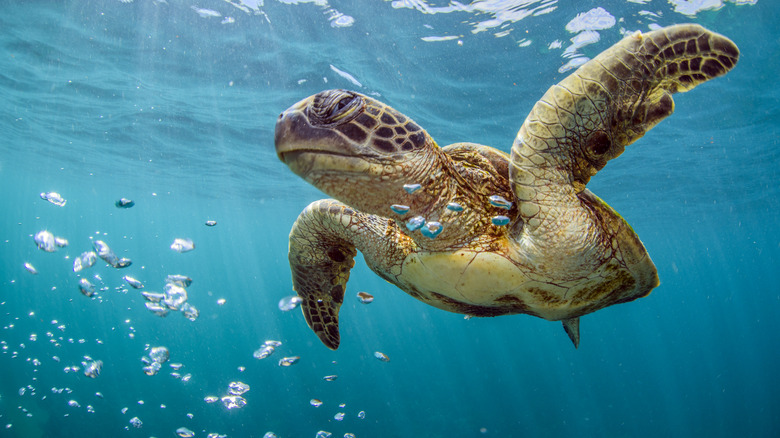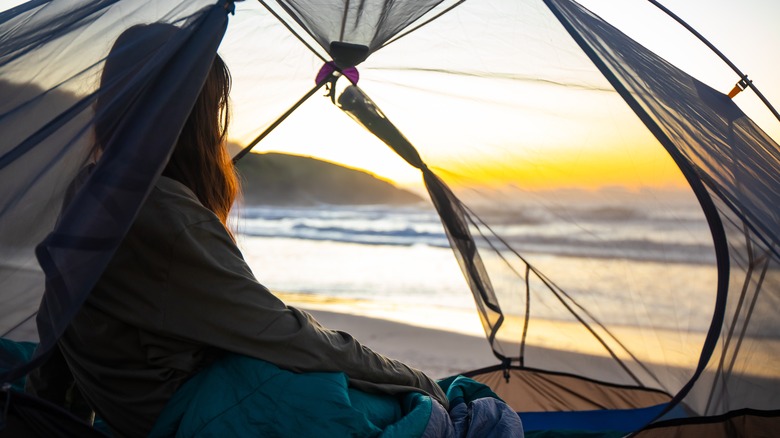The Best Beaches To Camp At In Australia, According To Travelers
Australians are an outdoorsy, beachy kind of people — actives who love to explore their country's world-famous coasts without too much muss or fuss. It comes as little surprise then that the continent's more than 21,000 miles of coastline are chock-a-block with all sorts of campsites, ranging from primitive camping to glamping eco-luxury.
We searched up and down the Land Down Under for beautiful beaches that offer great camping options. Most accommodations are still fairly rudimentary — be sure to bring your own fresh water, food (see how aluminum foil can elevate meals during camping), and batteries — but for many, that's part of the charm. People visit to get away from it all and to stay at or near the beach for, in some cases, as little as $15 a night per person. We start in a tropical rainforest in northern Queensland and work our way clockwise, south along Australia's Pacific coast. Then, through colonies of penguins and puffins in the far south of Tasmania, passing the staggering cliffs along the Great Ocean Road, before ending up in a beautiful tent overlooking one of the largest, most pristine coral reefs in the world.
Noah Beach, Queensland
Camping on a beach is already exciting, but things get really epic once you place rainforests and coral reefs next to each other. The Noah Beach camping area in northern Queensland offers 15 camping spots under the dense rainforest canopy of Daintree Rainforest. It is also just a few 100 feet away from the crystalline waters of Noah Beach, where the turquoise water of the Great Barrier Reef laps against the bright white sand.
The campground is the perfect stop for any rugged adventurer interested in an affordable and accessible way to experience the best of the reef and the rainforest. While the Daintree Rainforest is full of swanky eco-lodges that command hundreds of dollars nightly, the Noah Beach camping area only costs $6.55 per person per night or $26.20 per family per night. You get what you pay for: The accommodations are limited to drop toilet stalls, so guests should come with their own food, power, and water. Additionally, due to the forest canopy, guests cannot bring caravans, buses, or tall camper vans to the campground.
But for many, this is one of the best ways to intimately experience the jaw-dropping nature surrounding them. The 180-million-year-old Daintree Rainforest is the oldest rainforest in the world, eclipsing all other rainforests by at least 10 million years. It is also one of the most biologically diverse, brimming with flora and fauna seen nowhere else on Earth. And if you follow any of the forest creeks out onto the tropical beaches of the Great Barrier Reef, you can dive underwater for the brightly-colored kaleidoscope of the world's largest coral reef.
Flinders Beach, Queensland
Forget a single spot to camp on the beach: We have a whole island of them. About a 25-minute ferry from Brisbane (See the bridge offering stunning views of Brisbane's skyline) lies North Stradbroke Island, also known by its nickname "Straddie" or its Aboriginal name, "Minjerribah." The 123-square-mile island jutting out of the Queensland coast is a beachy paradise of turquoise waters, white sands, dolphins, kangaroos, koalas, and more. Minjerribah Camping operates beachfront campgrounds at 6 different beaches across the island, which include a total of over 500 campsites.
We recommend its campground on Flinders Beach at the northeast end of the island, which boasts over 200 sites. It is one of the most well-reviewed sites, with visitors saying it is better operated and quieter than alternatives on the island's busier East Side. It hosts tents, off-road camper trailers and caravans, and offers compostable toilets. Showers are available at the nearby Adder Rock Campground. Once you've gotten a good night's rest next to the sound of crashing waves, there's a whole island to explore.
Right outside is Flinders Beach, which boasts nearly 5 miles of pristine waters. It's a quieter beach, which means that it is unpatrolled, so for the safest swimming, head to Main Beach or Cylinder Beach on the other side of the island. Nearby, Point Lookout is said to offer some of the best surfing in Australia. Straddie is bursting with any sort of recreational activity you can imagine, from paddleboarding to kayaking to horse riding to cricket. Head a bit inland for amazing bushwalks brimming with native wildlife like wallabies or bandicoots, or head to charming villages like Amity Point or Dunwich for restaurants, galleries, or leisurely strolls.
Green Patch Beach, Jervis Bay Territory
Booderee means "Bay of Plenty" in the Dhurga language, and it's an apt description for this national park teeming with flora, fauna, history, and some of the whitest sand in Australia. Situated along the jagged 15,800-acre Bherwerre Peninsula about 3 hours south of Sydney, this unique park is full of bushland, kangaroos, wallabies, whales, dolphins, parrots, marshes, lagoons, and several achingly beautiful beaches.
Three of those beaches offer well-equipped campgrounds. At Green Patch Beach, a crescent-shaped beach where the whitest sand in Australia meets a giant turquoise patch of ocean, families can bring campers or tents into a bushland campground with fresh water, public toilets, and hot-water showers. Nearby, in bushland near the rocky shores of Bristol Point, lies another campground that also offers wood fireplaces and barbecues. On the southern end of the park, campers can set up shop in a grassy area close to Cave Beach, an incredible surfing beach famous for its stunning rock formations and sea caves. All campsites must be booked well in advance. Prices range from $30 a night for a small group during the off-season at Cave Beach or $180 for a large group during peak season at the campgrounds near Green Patch and Bristol Point.
In addition to the usual beach activities, visitors can enjoy hiking the majestic sea cliffs or peer at penguins swimming through the teal waters of Murray's Beach. Booderee is owned by the Wreck Bay Aboriginal Community, which co-manages the park with Parks Australia. Visitors can take guided tours to learn about the park's rich Aboriginal past and present, including over 100 prehistoric Aboriginal sites. The park also contains the Booderee Botanic Gardens, the only Aboriginal-owned botanic gardens in Australia.
Norman Beach, Victoria
Australia has saved up quite a symphony for its southernmost tip, a delightful tangle of rainforests, mangroves, and breathtaking beaches that squeak when you walk on them. To help adventurous spirits get the most out of Wilsons Promontory National Park, Australia has also preserved one of its most well-equipped campgrounds, the Tidal River Campground.
Though Wilsons Prom has a few campsites in its vicinity, Tidal River is by far the largest and most well-developed. Nestled amidst the bushland of the park's western end, under the shadow of the 1830-foot Mt. Oberon, and just a short walk from the soft white sands and turquoise waters of Norman Beach, it offers 484 camping and caravan sites. Though not all campsites are powered, all campers have access to blocks with hot showers, drinkable water, flushing toilets, laundry facilities, and garbage and recycling bins. Campers can also visit a well-equipped general store, which offers both groceries and take-out meals. In addition to its many campsites, Tidal River also offers luxurious Wilderness Retreat glamping cabins with beautiful decks and hardwood floors and 4 group lodges that can accommodate up to 30 people.
However you'd like to spend the night, there's no question that an incredible day awaits. Adventurous visitors can hike the summit of Mt. Oberon, where they'll be rewarded with staggering views of the azure ocean and dense green jungles. They can also walk through those jungles and mangrove forests, where they'll be able to spot kangaroos, wombats, wallabies, emus, and over 150 species of birds. And, of course, there are many beaches, from the white sands of Squeaky Beach to beautiful lookout areas like Norman Bay, Pillars Point, and South Point, the southernmost point in continental Australia.
Cloudy Bay, Tasmania
Wilsons Prom is the southernmost point in continental Australia, but if you set sail from South Point, you'll eventually end up in Tasmania. If you keep going south, then onto a ferry, and then drive south for another hour, you'll wind up at Cloudy Bay. As you gaze out into the great blue beyond, nothing except the ocean lies between you and Antarctica. Here's how to plan a trip to Antarctica.
Cloudy Bay lies in the far south of Bruny Island, a 140-square-mile island off the coast of Tasmania known for its beautiful beaches, rare birds, and epicurean delights. Cloudy Bay is one of the two main beaches on Bruny Island, and it is known for being a wonderful, windy surfing spot where you can gaze out at large waves and even larger cliffs on both sides. The closest campsites are the Cloudy Corners Campground and the Pines Campground. The former is a large campground that is only accessible to four-wheel drive vehicles and boasts its own boat launch. The latter has spots for tents, caravans, and campervans and pit toilets. Since Cloudy Beach is fairly quiet, no bookings are required.
About a 35-minute drive north lies Adventure Bay, a gorgeous beach great for swimming right off a town that's a little busier and near more attractions. In addition to its own campsite, Adventure Bay is near a general store, a bowling alley, and the departure point for the Bruny Eco Boat cruise. We recommend taking this three-hour cruise, where you'll be able to marvel at dolphins, whales, puffins, seals, and all the incredible caves and cliffs along the coast. You could easily spend a week exploring the many treasures of Bruny Island, which includes the long, scenic Bruny Island Neck isthmus, incredible gourmet food, birdwatching tours, and so much more.
Johanna Beach, Victoria
We now head back to one of the best stretches of the Australian mainland: the mind-blowing cliffs, crags, caves, and rainforests surrounding the 151-mile Great Ocean Road (here are the best stops to make on this route). About halfway through this storied route lies Johanna Beach, a world-famous surfing spot beach that has hosted international surfing competitions. You can enjoy the powerful waves and golden sand from the Johanna Beach Campground, a dog-friendly campsite that offers 25 non-powered sites in a lush, grassy area sheltered from the ocean's powerful winds.
During the day, Johanna Beach is a great spot to surf, fish, or stroll. The stroll doesn't end at the end of the beach, however. Johanna Beach also lies along the Great Ocean Walk, a 68-mile trek through some of the area's greatest attractions. Along the walk, you can pop into Great Otway National Park, a 255,000-acre rainforest filled with koalas dangling off fragrant eucalyptus trees, waterfalls pouring into flowing creeks, and Melba Gully, an emerald green canopy of ferns, mosses, and trees known as the "Jewel of the Otways." At night, the gully twinkles with the lights of thousands of glow worms.
Continue along either the Great Ocean Walk or the Great Ocean Road to explore some of the jaw-dropping rock formations along the Shipwreck Coast, named for the reason you'd expect. Johanna Beach was named for a schooner called the "Johanna" that sank off the coast in 1843. Don't miss London Bridge, the massive arch in the middle of the ocean; the Grotto, an incredible series of caves and arches; a beautiful bay encircled by massive cliffs; and the Twelve Apostles, 12 massive offshore limestone stacks that explode with color when the sun hits it at the right angle.
Lucky Bay, Western Australia
If you'd like to wake up to the sounds of crashing waves and a kangaroo pawing at your tent, there may be no better spot in the world than Lucky Bay, a beach in the southwest that, in 2023, Banana Boat named the world's best beach. With dazzling turquoise water and kangaroos hopping along the whitest sand in the world, what more do you need?
A place to stay nearby, for one. Lucky Bay boasts a large campground on its western side, which offers 56 unpowered sites. The campground also offers showers, toilets, and food preparation shelters with gas barbecues, dishwashing sinks, picnic tables, and benches. Most importantly, it offers great views of the blindingly blue water and bright white sand.
During the rest of the day, you and the colony of friendly kangaroos will share some magical adventures along that water and sand. You can walk along the 5 miles of white sand or go swimming, snorkeling, kayaking, or canoeing in the bay's calm, protected waters. Once you dry off, enjoy the miles of bushy trails running through Cape Le Grand National Park, a beautiful mix of tall, rocky mountains like Frenchman Peak, and a number of serene, clear, crescent-shaped beaches like Le Grand Beach and Hellfire Bay, which is much more pleasant than its name would have you believe. Just outside Lucky Bay lies a trail to Thistle Cove, home to staggering rock formations and boulders that whistle with the wind.
Pinky Beach, Western Australia
Kangaroos are special, but nothing will compare you for the overwhelming cuteness of a quokka, the symbol and namesake of Rottnest Island, our next destination. When Dutch explorer Willem de Vlamingh arrived in 1696, he mistook the marsupial, about the size of a domestic cat, for a giant rat and called the island Rottnest, Dutch for "rat's nest." Today, the island is still home to 10,000 quokkas, and many tourists try their best to get a selfie next to these friendly, impossibly cute teddy bears.
But quokkas are just a fraction of what's on offer on Rottnest Island, a 7.3-square-mile island located about an hour's ferry from Perth. It packs a lot into its boundaries. Of particular interest to this list is Pinky Beach, a beautiful stretch of white sand and calm, sheltered turquoise water framed by the historic Bathurst Lighthouse. It's a wonderful spot for swimming, some of the best snorkeling in the world, or enjoying ocean views and gourmet meals at the famous Pinky's Beach Club.
The sunsets and sunrises over Pinky Beach are widely lauded as some of the most beautiful anywhere, so if you'd like an affordable way to catch a glimpse of these, consider staying at the Rottnest Campground. The campground, located just a short walk from Pinky Beach, offers 43 non-powered campsites. Each campsite accommodates two tents and up to six people, and campers have access to a communal camp kitchen with cooking facilities.
Bottle Bay, Western Australia
If you like red, blue, and lagoons full of dugongs, you've come to the right place. Francois Peron National Park, located on a jagged isthmus sticking out into Shark Bay, is internationally renowned for its fiery red desert cliffs juxtaposed against the cobalt ocean. Inhabiting this world of red and blue are 35% of Australia's bird species and 26 species of endangered Australian mammals. The biodiversity of the Shark Bay Marine Park is so extraordinary that it has been declared a UNESCO World Heritage Site.
The park offers several beachside campsites as a jumping-off point for this otherworldly landscape. Near Bottle Bay, where ruby red sea cliffs pour into soft white sand, the Bottle Bay campground costs just $15 a night and offers toilets and barbecues. It is only accessible by a four-wheel-drive vehicle, which will be very handy overall in your travels around this hardy landscape. Basic camping facilities are also available at South Gregories, the eastern side of Herald Bight Park. The Big Lagoon Campground near a sheltered bay is the best-equipped, with sheltered decking, toilets, and barbecue facilities.
Even in Australia, home to some of the world's most unique ecosystems, Francois Peron National Park stands out. Two salt lagoons, known as birridas, are home to dolphins, green turtles, and dugongs, a large marine mammal related to the manatee. Ten thousand dugongs are located in Shark Bay, roughly 10% of the world's total population. Visitors can kayak through the lagoons or see them in all their glory from a scenic flight plane.
Sal Salis, Ningaloo Reef
Along this tour, we've mostly been roughing it, and that's been a part of the rustic charm. But to finish strong, we're splurging a little bit. We're sleeping right on the dunes, close enough to hear the waves and smell the salt air of the Indian Ocean, in a beautifully appointed eco-luxury tent. For our final stop, we're heading to Sal Salis Ningaloo Reef Safari Camp, a glamping experience offering 16 luxury safari tents just feet away from one of the world's most vibrant coral reefs.
You may never want to leave the comfort of your plush bed or gently swaying hammock overlooking turquoise waters, and there's certainly no rush to. But once you step out, you'll be treated to another UNESCO World Heritage Site, 185 miles of dugongs and manta rays and brightly-colored fish swimming around clear, pristine, turquoise water. While the famed Great Barrier Reef is sadly eroding due to warming water temperatures and coral bleaching, Ningaloo is in much better shape, and visitors will likely enjoy better sights and fewer crowds.
In addition to beautiful oceanside tents and gourmet meals, Sal Salis also offers guided reef tours, both on boats and snorkeling in the treasure trove beneath the waters. The resort also provides cruises through Yardie Creek Gorge, where visitors can learn about local history and enjoy sightings of wetland creatures like ospreys and egrets. If you still want to enjoy the many treasures of Ningaloo Reef in a more affordable style, the region offers plenty of more rustic campsites on and near the beach with more basic amenities.
Methodology
We looked through travel blogs and forums like TripAdvisor and Reddit to find incredible beaches with the best camping. We tried to find a variety of high-quality beaches around the country offering a diverse range of attractions, which offered well-run, well-reviewed campsites. Extra points went to beaches offering a diverse range of accommodations for all budgets.
